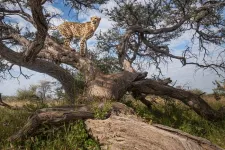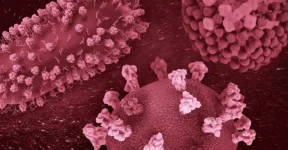(Press-News.org) Scientists have long been intrigued by the remarkable properties of spider silk, which is stronger than steel yet incredibly lightweight and flexible. Now, Fuzhong Zhang, a professor of energy, environmental and chemical engineering at the McKelvey School of Engineering at Washington University in St. Louis, has made a significant breakthrough in the fabrication of synthetic spider silk, paving the way for a new era of sustainable clothing production.
Since engineering recombinant spider silk in 2018 using bacteria, Zhang has been working to increase the yield of silk threads produced from microbes while maintaining its desirable properties of enhanced strength and toughness.
Higher yields will be critical if synthetic silk is to be used in everyday applications, particularly in the fashion industry where renewable materials are much in demand to stem the environmental impacts that come from producing an estimated 100 billion garments and 92 million tons of waste each year.
With the help of an engineered mussel foot protein, Zhang has created new spider silk fusion proteins, called bi-terminal Mfp fused silks (btMSilks). Microbial production of btMSilks have eightfold higher yields than recombinant silk proteins, and the btMSilk fibers have substantially improved strength and toughness while being lightweight. This could revolutionize clothing manufacturing by providing a more eco-friendly alternative to traditional textiles. The findings were published April 14 in Nature Communications.
“The outstanding mechanical properties of natural spider silk come from its very large and repetitive protein sequence,” Zhang said. “However, it is extremely challenging to ask fast-growing bacteria to produce a lot of repetitive proteins.
“To solve this problem, we needed a different strategy,” he said. “We went looking for disordered proteins that can be genetically fused to silk fragments to promote molecular interaction, so that strong fibers can be made without using large repetitive proteins. And we actually found them right here in work we’ve already been doing on mussel foot proteins.”
Mussels secrete these specialized proteins on their feet to stick to things. Zhang and his collaborators have engineered bacteria to produce them and engineer them as adhesives for biomedical applications. As it turns out, mussel foot proteins are also cohesive, which enables them to stick to each other well, too. By placing mussel foot protein fragments at the ends of his synthetic silk protein sequences, Zhang created a less repetitive, lightweight material that’s at least twice as strong as recombinant spider silk.
The yields on Zhang’s material increased eightfold compared with past studies, reaching 8 grams of fiber material from 1 liter of bacterial culture. This output constitutes enough fabric to test for use in real products.
“The beauty of synthetic biology is that we have lots of space to explore,” Zhang said. “We can cut and paste sequences from various natural proteins and test these designs in the lab for new properties and functions. This makes synthetic biology materials much more versatile than traditional petroleum-based materials.”
In coming work, Zhang and his team will expand the tunable properties of their synthetic silk fibers to meet the exact needs of each specialized market.
“Because our synthetic silk is made from cheap feedstock using engineered bacteria, it presents a renewable and biodegradable replacement for petroleum-derived fiber materials like nylon and polyester,” Zhang said.
Li J, Jiang B, Chang X, Yu H, Han Y, Zhang F. Bi-terminal fusion of intrinsically-disordered mussel foot protein fragments boosts mechanical strength for protein fibers. Nature Communications, April 14, 2023. https://doi.org/10.1038/s41467-023-37563-0
This research was supported by the United States Department of Agriculture (20196702129943) and National Science Foundation (DMR-2207879 and OIA-2219142).
END
Synthetic biology meets fashion in engineered silk
Engineers developed a method to create synthetic spider silk at high yields while retaining strength and toughness using mussel foot proteins
2023-04-20
ELSE PRESS RELEASES FROM THIS DATE:
Study reveals a novel biomarker and a potentially improved therapy for Multiple Sclerosis and related neurodegenerative disorders
2023-04-20
Houston, TX – Degeneration of myelin, an insulating sheath required for rapid communication between nerve cells, and neuroinflammation are notable hallmarks of Multiple Sclerosis (MS) and related neurodegenerative disorders such as Alzheimer’s disease or Huntington’s disease that affect roughly 2.8 million people in the world. However, little is known about the precise molecular steps by which demyelination leads to the loss of neurons and glia, the two major types of brain cells.
A paper published recently in Cell Metabolism by a research team led by Drs. Hugo J. Bellen, Hyunglok Chung, and Hyun ...
Dr. Elizabeth Whitlock to be honored at #AGS23 for her cross-cutting work in geriatrics, anesthesiology, and epidemiology
2023-04-20
New York, NY (April 20, 2023) — The American Geriatrics Society (AGS) and the AGS Health in Aging Foundation today announced that Elizabeth L. Whitlock, MD, an Assistant Professor in the Department of Anesthesia and Perioperative Care at the University of California, San Francisco (UCSF) is the 2023 recipient of the Jeffrey H. Silverstein Memorial Award for Emerging Investigators in the Surgical and Related Medical Specialties.
The award will be presented at the 2023 AGS Annual Scientific Meeting (#AGS23) which is being held in Long Beach, CA from May 4-6 (preconference day is May 3). The award recognizes Dr. ...
Extraction influences seismicity at some hydraulic fracturing sites in Ohio
2023-04-20
A decade’s worth of research at oil and gas operations in the central and eastern United States has confirmed that fluid injection from hydraulic fracturing and wastewater disposal can induce seismicity.
Now, data from hydraulic fracturing wells in eastern Ohio indicate that extraction activities also can influence the seismicity rate, according to a presentation at the Seismological Society of America (SSA)’s 2023 Annual Meeting.
During hydraulic fracturing, well operators inject a pressurized liquid ...
Cheetahs need more space: Reintroduction in India must consider their spatial ecology
2023-04-20
In autumn 2022 and winter 2023, a total of 20 cheetahs from Namibia and South Africa were introduced to Kuno National Park in India to establish a free-ranging population – for the first time since their extinction in India 70 years ago. Although the idea may be commendable, getting it right is not so easy. Scientists of the Cheetah Research Project of Leibniz-IZW in Namibia see shortcomings in the reintroduction plan: In southern Africa, cheetahs live in a stable socio-spatial system with widely spread territories and densities ...
From pathogens to fads: Interacting contagions
2023-04-20
APRIL 20, 2023
Most people think of a disease outbreak when they hear the word “contagion.” But it’s a concept that extends beyond pathogens. It could be an infectious disease, a fad, an online meme, or even a positive behavior in a population.
“From the mathematical perspective, a contagion is just a thing that spreads,” says Laurent Hébert-Dufresne, a former SFI Postdoctoral Fellow, now an associate professor in computer science at the University of Vermont.
April 19–21, Hébert-Dufresne and Juniper Lovato, ...
Beaver ponds with deeper sediments store more nitrogen, simple mapping reveals
2023-04-20
American Geophysical Union
20 April 2023
AGU Release No. 23-18
For Immediate Release
This press release and accompanying multimedia are available online at:
https://news.agu.org/press-release/beaver-ponds-with-more-sediments-store-more-nitrogen-simple-mapping-reveals/
Beaver ponds with deeper sediments store more nitrogen, simple mapping reveals
Simple mapping of beaver ponds can help land managers and conservationists in the West detect which ponds are sponging up nitrogen and which are releasing it
AGU press contact:
Rebecca Dzombak, +1 (202) 777-7492, news@agu.org (UTC-4 hours)
Contact information for the researchers:
Desneiges ...
New drug may help prevent migraine for difficult cases
2023-04-20
EMBARGOED FOR RELEASE UNTIL 4 P.M. ET, THURSDAY, APRIL 20, 2023
MINNEAPOLIS – The drug atogepant may help prevent migraines for people who have had no success with other preventive drugs, according to a preliminary study released April 20, 2023, which will be presented at the American Academy of Neurology’s 75th Annual Meeting being held in person in Boston and live online from April 22-27, 2023. The study involved people with episodic migraine, which is defined as having up to 14 headache days per month with migraine ...
ChatGPT is still no match for humans when it comes to accounting
2023-04-20
Last month, OpenAI launched its newest AI chatbot product, GPT-4. According to the folks at OpenAI, the bot, which uses machine learning to generate natural language text, passed the bar exam with a score in the 90th percentile, passed 13 of 15 AP exams and got a nearly perfect score on the GRE Verbal test.
Inquiring minds at BYU and 186 other universities wanted to know how OpenAI’s tech would fare on accounting exams. So, they put the original version, ChatGPT, to the test. The researchers ...
Researchers reveal a map to study novel form of cell-to-cell communication
2023-04-20
An international team led by researchers at Baylor College of Medicine with the National Institutes of Health Extracellular RNA Communication Consortium and the Bogdan Mateescu laboratory at the ETH Zürich and University of Zürich has developed a new powerful resource to study extracellular RNA (exRNA), a novel form of cell-to-cell communication. The study, published in the journal Cell Genomics, lays the foundation to examine how exRNA and its carrier proteins found in bodily fluids function in a healthy as well as a diseased setting, potentially providing a means to accurately implement early ...
ORNL’s Lupini elected fellow of the Microscopy Society of America
2023-04-20
Andrew Lupini, a scientist and inventor at the Department of Energy’s Oak Ridge National Laboratory, has been elected Fellow of the Microscopy Society of America.
MSA fellows are senior distinguished members who have made significant contributions to the advancement of microscopy and microanalysis through scientific achievement and service to the scientific community and the society. Lupini was one of only four scientists named an MSA Fellow this year.
Lupini was cited “for foundational contribution of theory and practice ...
LAST 30 PRESS RELEASES:
Injectable breast ‘implant’ offers alternative to traditional surgeries
Neuroscientists devise formulas to measure multilingualism
New prostate cancer trial seeks to reduce toxicity without sacrificing efficacy
Geometry shapes life
A CRISPR screen reveals many previously unrecognized genes required for brain development and a new neurodevelopmental disorder
Hot flush treatment has anti-breast cancer activity, study finds
Securing AI systems against growing cybersecurity threats
Longest observation of an active solar region
Why nail-biting, procrastination and other self-sabotaging behaviors are rooted in survival instincts
Regional variations in mechanical properties of porcine leptomeninges
Artificial empathy in therapy and healthcare: advancements in interpersonal interaction technologies
Why some brains switch gears more efficiently than others
UVA’s Jundong Li wins ICDM’S 2025 Tao Li Award for data mining, machine learning
UVA’s low-power, high-performance computer power player Mircea Stan earns National Academy of Inventors fellowship
Not playing by the rules: USU researcher explores filamentous algae dynamics in rivers
Do our body clocks influence our risk of dementia?
Anthropologists offer new evidence of bipedalism in long-debated fossil discovery
Safer receipt paper from wood
Dosage-sensitive genes suggest no whole-genome duplications in ancestral angiosperm
First ancient human herpesvirus genomes document their deep history with humans
Why Some Bacteria Survive Antibiotics and How to Stop Them - New study reveals that bacteria can survive antibiotic treatment through two fundamentally different “shutdown modes”
UCLA study links scar healing to dangerous placenta condition
CHANGE-seq-BE finds off-target changes in the genome from base editors
The Journal of Nuclear Medicine Ahead-of-Print Tip Sheet: January 2, 2026
Delayed or absent first dose of measles, mumps, and rubella vaccination
Trends in US preterm birth rates by household income and race and ethnicity
Study identifies potential biomarker linked to progression and brain inflammation in multiple sclerosis
Many mothers in Norway do not show up for postnatal check-ups
Researchers want to find out why quick clay is so unstable
Superradiant spins show teamwork at the quantum scale
[Press-News.org] Synthetic biology meets fashion in engineered silkEngineers developed a method to create synthetic spider silk at high yields while retaining strength and toughness using mussel foot proteins



